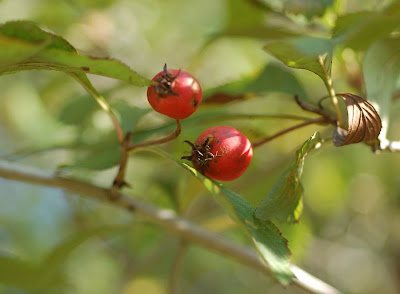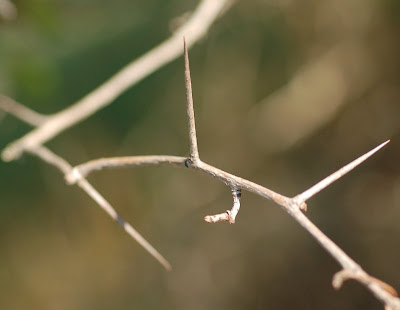
Lest you think my success at maple identification will make me arrogant, let me tell you about my recent attempt to identify the hawthorn species in our yard. It took me a while to convince myself that these were, in fact, hawthorn, because they didn't look like any hawthorns I was familiar with, and they definitely don't "match" pictures in "the book" or on the Interwebtubenet. The Flora of West Virginia and Gray's Manual of Botany eventually let me eliminate all the other local genera in the Rosaceae.
I knew that Crataegus species limits are tricky, and that there is hybridization, but I thought I might identify these shrubs to species group. Unfortunately, the initial couplets in the keys all concern leaf characters, and these little trees have extremely variable leaf morphology.
Lest you think I'm giving up prematurely, here's a synopsis of the Crataegus problem from the Dickinson lab at the University of Toronto:
Between 1896 and 1910 the number of North American Crataegus species increased dramatically. Many of these species were described by C. S. Sargent, director of the Arnold Arboretum. Sargent eventually expressed himself to a correspondent about his pleasure in traveling in South America, where no hawthorns grew....The large number of species described during this period...led W. H. Camp (1942) to enunciate what he saw as "the Crataegus problem."
....[T]he discovery of polyploidy and other evidence (e.g. widespread male sterility) of...hybridization has been studied in detail only in situations involving the Eurasian diploid species C. monogyna....Polyploid Crataegus are apomictic and are suspected of being of hybrid origin, but only apomixis has been studied in any detail, and that only recently (Campbell et al. 1991). Even so, new species of Crataegus continue to be described without discussion of whether they merely represent apomictic genotypes, or in fact comprise populations of different, panmictic genotypes.
And here are some Cratategus identification tips. Note the frequent use of the "spp." word.
- USDA Plants Database page for Crataegus
- Virginia Tech Tree ID for Crataegus spp.
- Crataegus spp. page from the University of Toronto Botany Page's Families of Vascular Plants Course Page. This is an interesting assemblage of information and links that I'll be visiting again.

3 comments:
I never bother trying to key out the hawthorns. I do like them a lot - they are one of my favorite shrubs - but life is too short.
Here in Missouri hawthorns are very variable and the taxonomy is a confused mess. I don't even try to key them out, as the distinguishing characteristics are rather subtle. I do distinguish between groups of related hawthorn species.
The presence of any hawthorn, though, usually signifies that the area is relatively unmodified.
Evidently, Sargent, who described so many Hawthorn species, came to hate them, or at least to be happy to visit hawthorn-free environments.
Our place is a long-neglected pasture, so these hawthorns are early forest invaders, kind of weedy and aggressive.
Post a Comment